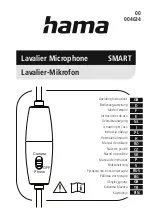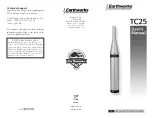
- 3 -
signal conditioner provides a zero-based, AC-coupled, output signal that is compatible with most
standard readout devices.
Many FFT analyzers, data acquisition modules, and data collectors have the proper constant-
current excitation built-in for direct use with ICP
microphones. Before using this feature, make
sure the supply voltage and constant current are within acceptable limits for use with your
particular microphone. (Check the enclosed
Specification Sheet.)
4.0 Installation and Operation
There are many ways to support the microphone to take measurements, from simply placing the
microphone in a clip to using a 2D array stand, as determined by your application and budget.
After you remove the microphone from its package and have read this operating guide, attach the
appropriate cable between the Signal Conditioner and the microphone. You will then need to
attach a second cable to connect the Signal Conditioner to your readout device. This is a standard
Coaxial cable with BNC connectors on each end. PCB offers these cables in a variety of lengths
for any application.
Figure 3
All of the 130 series Array Microphones are the “Free-Field” type. This type of microphone is
direction-sensitive and should be pointed directly at the object you are measuring. The “Free-
Field” type of microphone is best suited for applications where the sound is coming from one
defined direction, without any disturbing objects or hard surfaces that will reflect the sound or
cause reverberation. After completing the system setup, power on the signal conditioner and
allow 1 to 2 minutes for the system to stabilize. The meter (or LED) on the signal conditioner
should be reading “green”. This indicates proper operation and you may begin taking
measurements. If a faulty condition is indicated (red or yellow reading), first check all system
connections, then check the functionality of the cable and signal conditioner. If the system still
does not operate properly, consult a PCB Application Engineer.
5.0 Calibration
All PCB microphones come with a certificate of calibration and compliance with ISO 9001 and
ANSI/NCSL Z540.3. The microphone is traceable to one or more of the following National Labs
(NIST, PTB or DFM), and calibration records are on file. PCB utilizes the “Back-to-Back
Reference” form of calibration. The microphone is checked against a test and measurement
working standard microphone and must meet specifications before it can be shipped. An example
of a calibration certificate is shown below (Figure 4).
When used in conjunction with a
large number of signals, for
simultaneous measurement, the
microphones can be clipped onto a
grid network to form a complete
array. See Figure 3.
Summary of Contents for 130E22
Page 10: ......




























